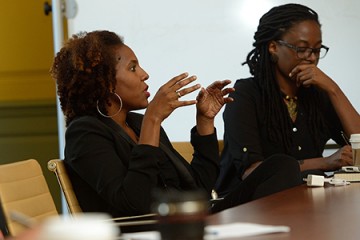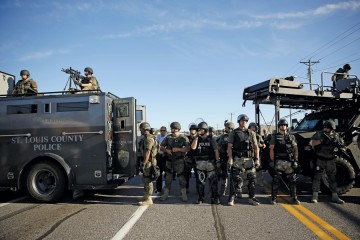Teacher and Black Lives Matter activist DeRay Mckesson spoke Thursday night in Shriver Hall on the Johns Hopkins University Homewood campus about the militarization of police and the changing face of activism in the age of technology.
Speaking as part of the student-run Milton S. Eisenhower Symposium, Mckesson said that in 2014, he became engrossed in the story of the shooting death of Michael Brown by police officer Darren Wilson and the subsequent mass protests in Ferguson, Missouri.
He said he was struck by the disparities in reports by major news outlets and what the public reported on social media.
"On CNN, it looked like the protesters were wrong," said Mckesson, a Baltimore native who holds a cabinet position with Baltimore City Schools. "And then I saw what was happening on Twitter, and on Twitter, it looked like the police were wrong. I just wanted to go see for myself."
Mckesson sent a Facebook message requesting a couch to sleep on, then drove nine hours from Michigan to St. Louis, arriving on the first night a curfew was enforced in the city and suburbs. What he encountered during the protests in Ferguson was unlike any form of policing he had seen before, he said.
Projecting on a screen in Shriver Hall, Mckesson showed cell phone photos, tweets, and videos of officers kicking at the interlocked arms of protesters seated outside a convenience store, or shoving protesters in the back—including elderly women—to force them out of municipal buildings. He said that the police, in riot gear and helmets, would form blockades and beat their batons on their riot shields as they advanced in unison to force protesters to disperse.
"This was about power for them," Mckesson said. "It was about showing us that they can move our bodies. It was about forcing us to be anywhere they wanted."
But the protesters proved more savvy on social media than the police, and Twitter quickly became a tool for organizing thousands of people without alerting authorities, Mckesson said. And the recorded footage of interactions with police allowed each protester to document their experience and share it around the world.
"Vine was our savior," he said of the video platform that loops six-second videos. "These were the clips that were playing on the news at night, it was these clips that helped us show what was happening."
Also see
A movement had been born in Ferguson, Mckesson said.
"So much of the protest was about forcing a conversation [about police brutality] that wasn't happening otherwise," he said. Now, after meetings with top government officials, including a four-hour meeting with President Barack Obama and top police chiefs, Mckesson said the conversation is taking place across the nation, and the movement must pivot to the next step of social organizing. He hinted that it might entail creating a centralized online outlet to help people access reading materials, research, and information on police violence.
Perhaps most importantly, Mckesson said that technology and social media—specifically Twitter and live-streaming platforms like Periscope—allow African-Americans to control how their stories are told.
"People of color are always facing issues of erasure, and erasure operates in two ways—one, the story is never told, or it's told by everyone but us," Mckesson said. "And in this moment, we became the unerased."
Posted in Voices+Opinion, Politics+Society










